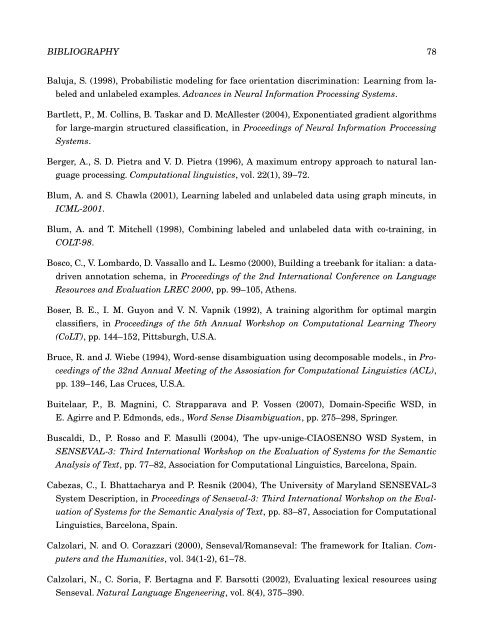Automatic Extraction of Examples for Word Sense Disambiguation
Automatic Extraction of Examples for Word Sense Disambiguation
Automatic Extraction of Examples for Word Sense Disambiguation
You also want an ePaper? Increase the reach of your titles
YUMPU automatically turns print PDFs into web optimized ePapers that Google loves.
BIBLIOGRAPHY 78<br />
Baluja, S. (1998), Probabilistic modeling <strong>for</strong> face orientation discrimination: Learning from la-<br />
beled and unlabeled examples. Advances in Neural In<strong>for</strong>mation Processing Systems.<br />
Bartlett, P., M. Collins, B. Taskar and D. McAllester (2004), Exponentiated gradient algorithms<br />
<strong>for</strong> large-margin structured classification, in Proceedings <strong>of</strong> Neural In<strong>for</strong>mation Proccessing<br />
Systems.<br />
Berger, A., S. D. Pietra and V. D. Pietra (1996), A maximum entropy approach to natural lan-<br />
guage processing. Computational linguistics, vol. 22(1), 39–72.<br />
Blum, A. and S. Chawla (2001), Learning labeled and unlabeled data using graph mincuts, in<br />
ICML-2001.<br />
Blum, A. and T. Mitchell (1998), Combining labeled and unlabeled data with co-training, in<br />
COLT-98.<br />
Bosco, C., V. Lombardo, D. Vassallo and L. Lesmo (2000), Building a treebank <strong>for</strong> italian: a data-<br />
driven annotation schema, in Proceedings <strong>of</strong> the 2nd International Conference on Language<br />
Resources and Evaluation LREC 2000, pp. 99–105, Athens.<br />
Boser, B. E., I. M. Guyon and V. N. Vapnik (1992), A training algorithm <strong>for</strong> optimal margin<br />
classifiers, in Proceedings <strong>of</strong> the 5th Annual Workshop on Computational Learning Theory<br />
(CoLT), pp. 144–152, Pittsburgh, U.S.A.<br />
Bruce, R. and J. Wiebe (1994), <strong>Word</strong>-sense disambiguation using decomposable models., in Pro-<br />
ceedings <strong>of</strong> the 32nd Annual Meeting <strong>of</strong> the Assosiation <strong>for</strong> Computational Linguistics (ACL),<br />
pp. 139–146, Las Cruces, U.S.A.<br />
Buitelaar, P., B. Magnini, C. Strapparava and P. Vossen (2007), Domain-Specific WSD, in<br />
E. Agirre and P. Edmonds, eds., <strong>Word</strong> <strong>Sense</strong> <strong>Disambiguation</strong>, pp. 275–298, Springer.<br />
Buscaldi, D., P. Rosso and F. Masulli (2004), The upv-unige-CIAOSENSO WSD System, in<br />
SENSEVAL-3: Third International Workshop on the Evaluation <strong>of</strong> Systems <strong>for</strong> the Semantic<br />
Analysis <strong>of</strong> Text, pp. 77–82, Association <strong>for</strong> Computational Linguistics, Barcelona, Spain.<br />
Cabezas, C., I. Bhattacharya and P. Resnik (2004), The University <strong>of</strong> Maryland SENSEVAL-3<br />
System Description, in Proceedings <strong>of</strong> <strong>Sense</strong>val-3: Third International Workshop on the Eval-<br />
uation <strong>of</strong> Systems <strong>for</strong> the Semantic Analysis <strong>of</strong> Text, pp. 83–87, Association <strong>for</strong> Computational<br />
Linguistics, Barcelona, Spain.<br />
Calzolari, N. and O. Corazzari (2000), <strong>Sense</strong>val/Romanseval: The framework <strong>for</strong> Italian. Com-<br />
puters and the Humanities, vol. 34(1-2), 61–78.<br />
Calzolari, N., C. Soria, F. Bertagna and F. Barsotti (2002), Evaluating lexical resources using<br />
<strong>Sense</strong>val. Natural Language Engeneering, vol. 8(4), 375–390.

















